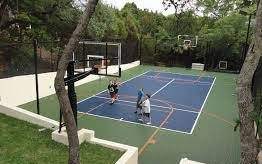Introduction:
Having a backyard court is a fantastic way to bring fun, fitness, and recreation right to your doorstep. Whether you’re interested in basketball, tennis, volleyball, or other sports, creating a dedicated space in your backyard can provide endless entertainment for family and friends. In this beginner’s guide, we will explore various backyard court ideas to help you plan and design a functional and enjoyable space. From court dimensions to surface options, we’ll cover the essential elements to consider when creating your backyard court.
Determine the Court’s Purpose and Size:
First, decide which sports or activities you want to accommodate in your backyard court. If basketball is your main focus, consider the dimensions of a regulation basketball court (94 feet long by 50 feet wide). However, you can scale it down to fit your available space and needs. For tennis, the standard court size is 78 feet long by 36 feet wide, but you can opt for a smaller size for recreational play. Additionally, multi-sport courts that combine various game lines are becoming increasingly popular. Determine the appropriate size based on the sports you wish to play and the available space in your backyard.
Choose the Court Surface :
The choice of court surface depends on your preferences, budget, and the specific sport you plan to play. Here are a few popular options:
- Concrete: Concrete is a durable and low-maintenance surface suitable for basketball, tennis, and other sports. It provides a consistent bounce and requires minimal upkeep.
- Asphalt: Asphalt is another cost-effective option that provides good traction and durability. It’s commonly used for basketball courts but can also be used for other sports.
- Modular Tiles: Modular tile systems are easy to install and offer excellent shock absorption, reducing the risk of injuries. They provide versatility and can be used for various sports. Additionally, they can be removed or reconfigured if needed.
- Synthetic Turf: Synthetic turf is ideal for sports like tennis or soccer. It provides a cushioned surface and requires minimal maintenance. It’s also weather-resistant and can withstand heavy use.
Consider Lighting and Fencing
To extend the playing time and ensure safety, consider installing lighting around the court. LED floodlights are energy-efficient and provide ample illumination for evening games. Proper fencing is essential to keep the ball within the court boundaries and provide privacy. Choose a sturdy and durable fencing material, such as chain-link, vinyl, or wood. Ensure that the fence height complies with local regulations and consider adding padding to protect players from impact.
Add Accessories and Amenities
Enhance your backyard court with additional amenities to make it even more enjoyable. Install a basketball hoop, adjustable in height for players of all ages. Elevate your backyard court experience by incorporating a durable and high-quality basketball backboard, complementing the installed hoop and ensuring authentic and enjoyable play. Consider adding seating areas, a scoreboard, or a shade structure to create a comfortable environment. You can also incorporate landscaping elements, such as shrubs or flower beds, to beautify the surroundings. Don’t forget to have storage for sports equipment, like a dedicated shed or storage unit.
Safety and Maintenance
Safety should be a top priority when designing your backyard court. Ensure proper surface preparation to avoid uneven areas or cracks. Use non-slip coatings or textured surfaces to prevent slips and falls. Install adequate padding on posts, fences, and other potential collision points. Regularly inspect and maintain the court surface to address any cracks, damage, or wear.
Conclusion:
Creating a backyard court opens up a world of possibilities for active play and recreation. By considering the purpose, size, surface options, and additional amenities, you can design a backyard court that provides endless fun for you, your family, and your friends.

